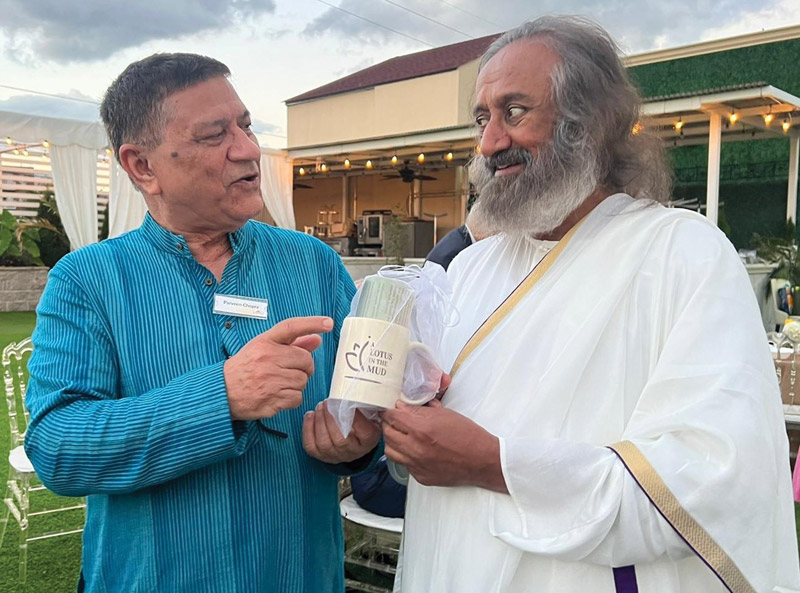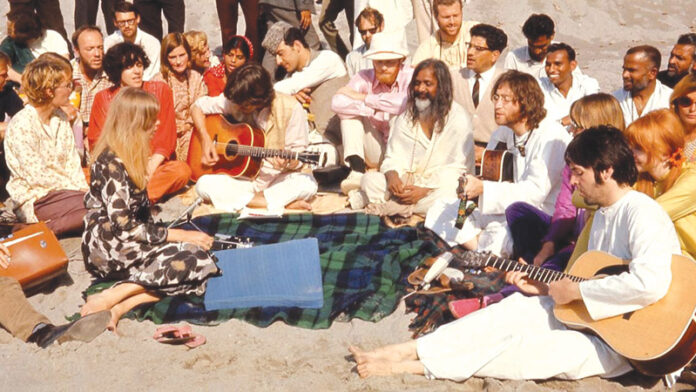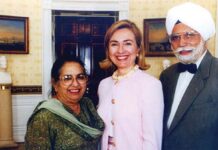
NEW YORK: “Why don’t you become a guru yourself?”
This is the question I have frequently been asked ever since I started teaching meditation in the 1980s. I moved on to start India’s first wellness in New Delhi and then relocated to New York to establish a wellness and spirituality website.
Along the way, I have encountered many famous gurus, including Maharishi Mahesh Yogi who globally popularized Transcendental Meditation (TM), new-age guru Deepak Chopra and Sri Sri Ravi Shankar who established the Art of Living Foundation. I also encountere d some women gurus and even faced wrath from a couple of them.
When people ask me `why don’t you become a guru yourself?’, they imply slyly that gurudom is a lucrative business these days. So I leave this topc here.
Maharishi Yogi and the gurus he created
After learning Transcendental Meditation (TM), I had the opportunity to do an advanced course in the presence of Maharishi Mahesh Yogi in Rishikesh – the yoga capital of the world. He was already famous in the world – the Beatles sat his lotus feet in the bare bones Rishikesh ashram.
Maharishi had developed an advanced TM-Sidhi course and held demonstrations of yogic flying. In the course I attended, I never mustered a smooth flight, only some hopping.
Then I was packed off to Tirupati in south India for the next advanced course. The now worldwide famous guru Sri Sri Ravi Shankar was my co-participant in that advanced course.
Ravi Shankar was a shy, soft-spoken man. His trump card: a unique mix of modern and Vedic education. To groom him, Maharishi Mahesh Yogi squirreled him away to his headquarters in Switzerland. Over time, he must have moved up in the hierarchy. Eventually, he parted with Mahesh Yogi, added the prefix Sri Sri to his name and went on to build a mammoth organization under the brand name The Art of Living.

Interestingly, Deepak Chopra, an endocrinologist by profession, was also groomed by Maharishi Yogi who wanted him to be his messenger. Brihaspati Dev Triguna, the grand old man of Ayurveda, once told me in Delhi, that Chopra was directed by Mahesh Yogi to pick up some rudimentary Ayurveda from him.
Facing female gurus’ wrath
In the early 1990s, while working for India Today I wrote a cover story on the new crop of gurus. I wrote most of the profiles myself, but a local correspondent wrote the profile of one south Indian woman guru. In that profile was one objectionable line which quoted an elderly man saying that he had known her as a little girl when she ran around naked. Irate followers of her flooded us with angry letters and phone calls. One businessman, who was a friend of India Today chief editor Aroon Purie, exerted such pressure that India’s foremost magazine had to apologize in print.
In yet another profile of a female guru, I used a picture showing her with legs stretched out and her lotus feet facing the camera. Her disciples took umbrage.
First dealing with gurus while learning TM and later writing about them while working for India Today amde me realize there was ahuge scope for a magazine dealing in the body-mind-spirit niche. So, I quit India Today to found India’s first wellness monthly Life Positive.
At Life Positive, we became the chroniclers of the new wave of Reiki, Vaastu Shastra, Landmark Forum, and such systems, interviewing upcoming gurus, alternative medicine practitioners, and motivational speakers. It was fun to become the go-to guy for journalists researching related stories.
Shirdi Sai Baba connection
One story I am proud of doing was about Shirdi Sai Baba (not to be confused with Sathya Saia Baba, he of the afro-hair). This was 1996, and I noticed that spontaneously, Sai Baba temples were coming up all over India, without the Sansthan managing the original temple in Shirdi, Maharashtra, having to lift a finger. That issue of Life Positive sold very well. Later, we did a cover story on Sri Sri Ravi Shankar, which became another bestselling edition.
Shirdi Sai temples have multiplied worldwide, even in the USA and Canada. Quite a few of them have been founded by one man—C.B. Satpathy, who curiously started his career as an Indian Police Service officer. I interviewed him when queues could be seen outside his government-allotted house in south Delhi. They were people desperately seeking solutions to their problems with help from his intuitive astrology.
Satpathy also had a pyramid in his backyard. A photo of him in the colorfully lit pyramid that I had curated ended up on the cover of India Today, adding to his fame. He retired as Director General of Police in 2008 and has devoted himself as a torchbearer for Sai Baba’s message of service, compassion, love, peace, and tolerance, becoming a guru in his own right.
I lost touch with Satpathy ji after moving to the US. Here, I came across another man whose devotion and zeal inspired him to open at least two Sai Baba temples in New York and New Jersey. His name is Dr Dattatreyudu Nori. He is an eminent radiation oncologist sought after by Indian politicians and bureaucrats seeking cancer treatment in America. India has honored him with a Padma Shri.
Many gurus like Asaram Bapu have been embroiled in sex scandals, which are duly reported by the Indian media. But one Indian-style American guru’s fall from grace was unexpected, with not a whiff of sex in the story. He married an Indian named Anita Anand, and in my calculus, being married halves the chances of a man’s sexual misconduct.
At Life Positive, we wrote about Andrew Cohen and his ‘evolutionary enlightenment’ theory. For some years, the Massachusetts-based Andrew published a widely circulated magazine titled ‘What is Enlightenment?’ His Wikipedia profile alleges he was “credibly accused of physically and psychologically abusing his students, and demanding money and extreme devotion” from them. His mother, Luna Tarlo, wrote a critical book titled ‘The Mother of God’ about her experience as his disciple. He apologized and took a sabbatical before resuming his work in 2016 in a low-key manner while based in India.
How to deal with gurus
The best advice I can give is from Gautam Buddha’s last words: “Be a lamp unto yourself.” When he was old and frail and dying, his close disciples were desolate and inconsolable. Appo deepo bhava, the Buddha comforted them.
Yes, a guru, who may be a few paces ahead of you in spiritual evolution, is needed, but only to show the path. The journey must be made by yourself. The Buddha said, “Follow the Dhamma, the teaching.” Similarly, the 10th Sikh Guru, Gobind Singh, told his people that the Guru Granth Sahib, their holy book, would be the Master after him.
Never let go of your critical thinking faculty. The Buddha even recommended a litmus test to discriminate between right and wrong spiritual advice: “Do not be satisfied with hearsay, tradition, or any teachings however they may come to you. Only when you know in yourself that things are wholesome, blameless, and commended by the wise and when adopted and practiced lead to welfare and happiness should you practice them. When they lead to virtue, honesty, loving-kindness, clarity, and freedom, then you must follow these.” (Quoted by Jack Kornfield in ‘A Path with Heart: A Guide Through the Perils and Promises of Spiritual Life’)
Meditation advice from a reluctant guru
Let me share what I learned from teaching meditation early in my life in Chandigarh. I learned that even highly religious, very educated, and accomplished people need to understand what spirituality is and what can lie beyond ritualistic worship. Every major religion has spirituality at its core – the mysticism part. In recent times, with meditation going mainstream (albeit far behind yoga), many gurus belonging to diverse traditions have included some modicum of meditation in their teaching mix.
In modern times, we need meditation more than ever because we have moved far away from the quiet state. Have you noticed that we almost never close our eyes except when going to sleep? Young people stay glued to their mobile phones until just before bed.
So, take out some me-time. Try closing your eyes, not doing anything, not thinking of anything. Not trying hard not to think of anything. Just watch the thoughts come and go. Try to remain aware. Lo! I have just let you on to the simplest meditation. In Transcendental Meditation, we use a monosyllabic mantra. You can pick a holy name from your religion, introduce it mentally, and return to it gently when you notice you got distracted by a thought. Keep it up for about 20 minutes, and see it quieten your mind, even giving you a fleeting no-thought-no-mantra experience.
Another technique that does not need much instruction is from Vipassana, the system said to have been taught by Lord Buddha. Called anapana or anapana-sati (Pali for mindfulness of breathing), it involves watching your breath with closed eyes. Just become aware of each inhalation and exhalation—the breath going in and going out, in and out. Your attention will move away from watching the breath; just bring it back.
So don’t wait for a guru. At a time when information about meditation and spiritual practices is available at the flick of a mouse, learn what you need and become your guru.
(Based in New York, Parveen Chopra is the founder of www.alotusinthemud.com)
READ NEXT: How Indian influenced the Beatles








